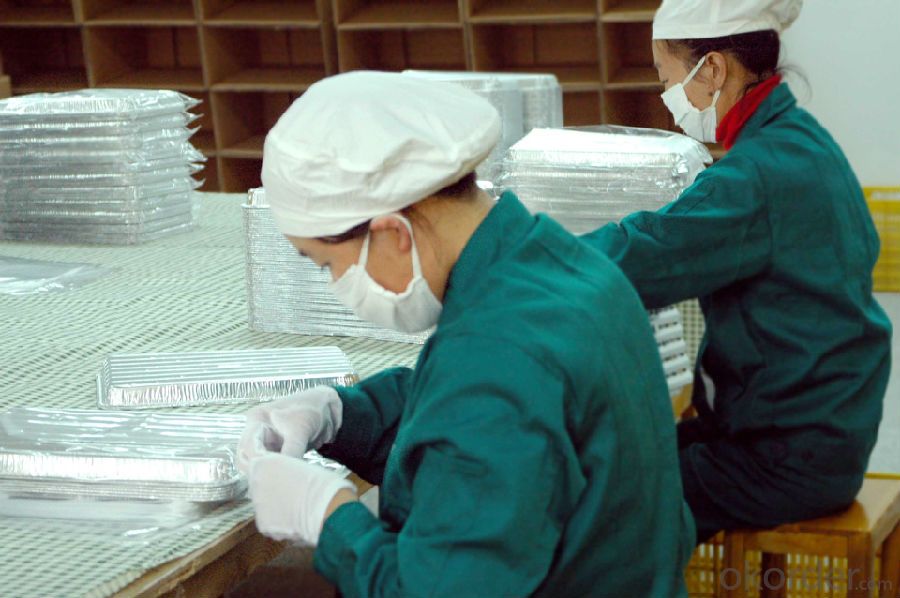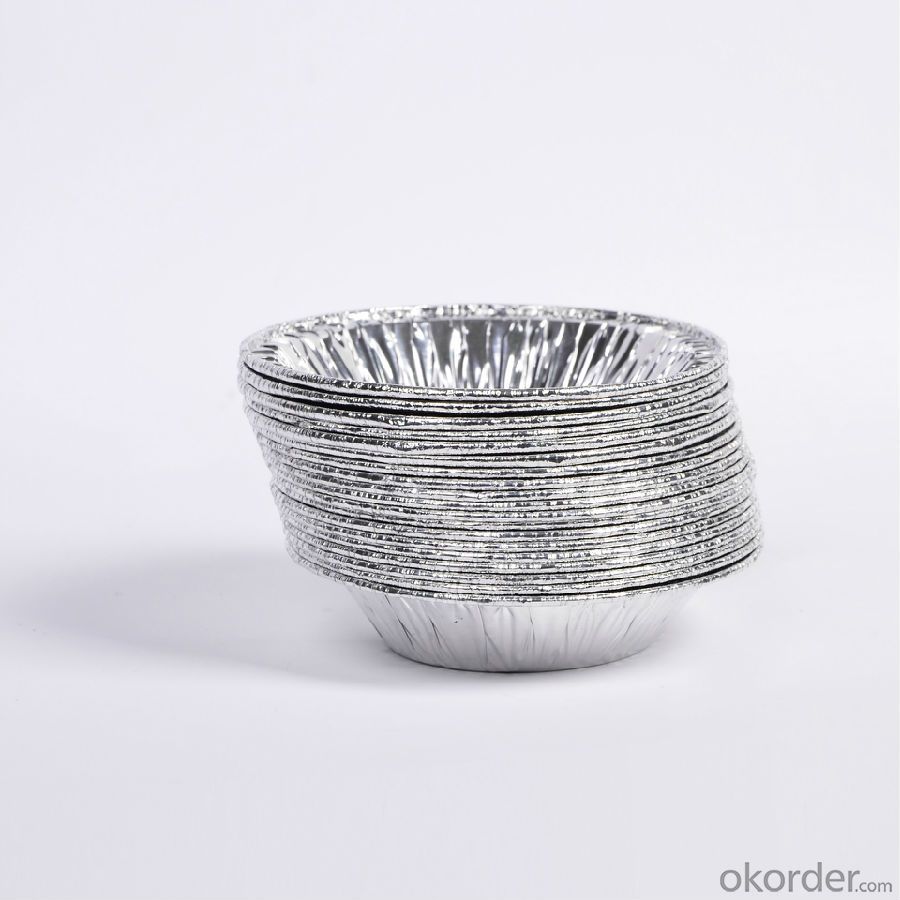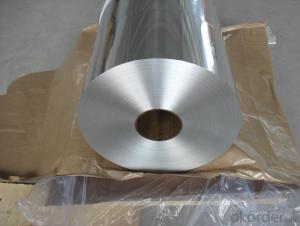Aluminium Foil for Food Container with Best Quality
- Loading Port:
- Shanghai
- Payment Terms:
- TT OR LC
- Min Order Qty:
- 5 m.t.
- Supply Capability:
- 2000 m.t./month
OKorder Service Pledge
OKorder Financial Service
You Might Also Like
Item specifice
Structure of Aluminium Foil for Food Container with Best Quality Description:
We have more than 10 years experiences on manufacturing kinds of aluminum profiles, such as Aluminum Window & Door profiles, Aluminum tile trim profiles, Aluminum profiles for LED light, Round/Square General profiles, Aluminum heat sink, Aluminum heating insulation profiles, Curtain wall Aluminum profiles, and others Industry profiles.
Our products have exported to all over the world, and we also have a large of market share in Algeria, Angola, Philippine, Guinea, Ghana, South Africa, Nepal, Nigeria, Tanzania, Iraq etc.
Main Features of the Aluminium Foil for Food Container with Best Quality:
1, Strong R&G: help customers finalize the design, strong tool design ability, excellent, pressing and surface treatment technology;
2, Strong quality management: ISO&SGS SYSTEM;
3, 24 hours on-line communication, professional, patient, flexible;
4, High capacity of manufacturing and wide range of products;
5, We can provide secondary manufacturing.
6, High corrosion resistance, high weather resistance and good wear resistance.
7, Alternative surface treatment: Colorful ANODIZE, POWDER COATING, ELECTROPHORESIS & WOODEN GRAIN. Plentiful colors upon your needs.
8, Excellent material for smooth and subtle edges, elegant appearance.
9, Strong coated adhesion which is suitable for construction and industrial material.
Images of the Aluminium Foil for Food Container with Best Quality:



Aluminium Foil for Food Container with Best Quality Specification:
Material | Alloy Aluminum 6063,6061,6005 or customer nominated |
Temper | T3, T4, T5, T6 |
Surface | Anodize, electrophoresis, powder coating, PVDF coating, wood grain painting, matted, etc. |
Colour | Any colour based on Standard Germany RAL Mark |
Length | Coating 6.5 meters, Anodizing 6.5 meters, Mill finish 5 meters |
Press Machine | 500-4000 tons all together 64 press lines. |
Fabrication | 1. Windows and doors; 2. Drilling; 3. Bending; 4. Cutting; 5. etc. |
Certificate | ISO 9001 |
Moulding | 1. Using our moulds, no fee; |
2. Using customer drawing, opening mould, usually about 10~50 tons then the moulding can be refunded. | |
3. Mould cost is negotiable base on the order quantity | |
Capability | Annual output 100,000 tons |
FAQ:
1.Q: What about leadtime ?
A: Normally the leadtime is 60days after we receive the deposit and confirm the details. All the press machines we use is the best quality in China Yangli brand. The press machine leadtime from Yangli is 50days, the best leadtime we can give is 60days.
2.Q: What's the lead time for moulds?
A: Normally the mould leadtime is 45 days after we confirm all the details with customer. Our professional mechanical enginners from Austria will design the mould according to the samples from customer, or by the specifications offered by customers.
3.Q:What kinds of mould you can make? and what is your strong point for the moulds?
A: we can make wrinkle wall mould and smooth wall mould both. For wrinkle wall mould we can make, 79" pan, fish pan, bbq pan. For smooth wall mould we can make muffin cup, and cake cup, tar cup,etc. We can also make 2 or 3 portion conatiner moulds as long as you offer us sample or specifications. Our strong points are all our moulds are WEDMLS cut, which makes the mould more accurate and precise. Important materials likestainless steel parts we make in Austria. We also recut after heat treatment, which most of makers do not take this process.
- Q:What are the different cutting methods for aluminum profiles?
- There are several different cutting methods that can be used for aluminum profiles, depending on the specific requirements and desired outcome. Some of the most common cutting methods for aluminum profiles include: 1. Saw cutting: This method involves using a saw blade to cut through the aluminum profile. Saw cutting is a versatile and widely used method that can produce straight cuts with high precision. It is suitable for both small and large-scale production. 2. Shearing: Shearing involves using a guillotine-like tool to cut through the aluminum profile. It is a quick and efficient method for cutting straight lines in aluminum profiles of various thicknesses. However, it may not be suitable for cutting complex shapes or angles. 3. CNC machining: Computer numerical control (CNC) machining is a highly precise cutting method that uses computer-controlled machines to cut aluminum profiles. It offers a wide range of cutting options, including complex shapes, angles, and contours. CNC machining is ideal for custom or intricate designs, but it can be more time-consuming and costly compared to other methods. 4. Laser cutting: Laser cutting uses a high-powered laser beam to cut through the aluminum profile. It is a precise and efficient method that can produce intricate and detailed cuts with minimal heat distortion. Laser cutting is highly suitable for thin aluminum profiles and is commonly used in industries such as aerospace and automotive. 5. Waterjet cutting: Waterjet cutting uses a high-pressure stream of water mixed with an abrasive material to cut through the aluminum profile. It is a versatile method that can cut through various thicknesses and materials, including aluminum. Waterjet cutting is ideal for cutting complex shapes and has minimal heat-affected zones. 6. Plasma cutting: Plasma cutting involves using a plasma torch to cut through the aluminum profile. It is a fast and efficient method that can handle thicker aluminum profiles. However, the heat generated during plasma cutting can cause distortion and may require additional post-cutting processes. Overall, the choice of cutting method for aluminum profiles depends on factors such as the desired cut quality, complexity of the design, production volume, and budget. It is essential to consider these factors to select the most suitable cutting method for your specific application.
- Q:Can aluminum profiles be used in transportation and logistics applications?
- Aluminum profiles find common usage in transportation and logistics applications, owing to their lightweight yet robust nature. This makes them an ideal choice for various components in the industry. Within the automotive sector, aluminum profiles are employed in the production of car frames, chassis, and body panels. Their lightweight quality aids in reducing vehicle weight, leading to enhanced fuel efficiency and lower emissions. Moreover, aluminum profiles exhibit excellent resistance to corrosion, ensuring vehicle longevity even in harsh environmental conditions. The aerospace industry heavily relies on aluminum profiles for the construction of aircraft structures, including wings, fuselage, and landing gear. The high strength-to-weight ratio of these profiles allows for increased payload capacity and improved fuel efficiency. Furthermore, aluminum profiles can withstand extreme temperature fluctuations and possess good electrical conductivity, rendering them suitable for diverse aerospace applications. In the logistics sector, aluminum profiles are utilized in the creation of cargo containers, pallets, and storage racks. Their lightweight nature facilitates easy handling and transportation of goods. Additionally, these profiles offer high resistance to rust and corrosion, ensuring the durability of logistics equipment, even in humid or corrosive environments. Moreover, aluminum profiles can be easily customized and fabricated to meet specific design requirements in transportation and logistics applications. Their extrudability into various shapes and sizes allows for versatility in design and functionality. Furthermore, aluminum profiles offer flexibility in assembly and maintenance, as they can be joined using different methods like welding or fastening. To sum up, the lightweight, strong, corrosion-resistant, and versatile properties of aluminum profiles make them highly suitable for transportation and logistics applications. They confer various benefits, such as improved fuel efficiency, increased payload capacity, and durability in harsh environments. Consequently, aluminum profiles find extensive use in the automotive, aerospace, and logistics industries for various components, thereby contributing to the efficiency and reliability of transportation and logistics systems.
- Q:Can aluminum profiles be used for lighting fixtures or systems?
- Yes, aluminum profiles can be used for lighting fixtures or systems. Aluminum is a lightweight and versatile material that is commonly used in the construction of lighting fixtures due to its durability, corrosion resistance, and heat dissipation properties. Aluminum profiles can be easily fabricated into various shapes and sizes, making them suitable for different lighting applications such as recessed lighting, track lighting, pendant lighting, and more. Additionally, aluminum profiles can be anodized or coated with different finishes to enhance their aesthetic appeal and protect them from environmental elements. Overall, the use of aluminum profiles in lighting fixtures or systems allows for efficient and effective lighting solutions while maintaining a sleek and modern design.
- Q:What are the benefits of using aluminum profiles in interior design?
- Using aluminum profiles in interior design offers several benefits. Firstly, aluminum is a lightweight material, making it easy to handle and install. This allows for flexibility in design, as it can be easily shaped and formed to create unique and intricate patterns. Secondly, aluminum profiles are durable and long-lasting, ensuring that the interior design elements will stand the test of time. They are resistant to corrosion, moisture, and UV rays, making them suitable for various environments, including bathrooms and outdoor spaces. Additionally, aluminum profiles are highly customizable, with a wide range of finishes and colors available. This allows designers to create a cohesive look and feel throughout a space, matching the profiles to other elements such as furniture or fixtures. Furthermore, aluminum profiles are eco-friendly, as they can be recycled and reused. This aligns with sustainable design practices and contributes to reducing environmental impact. Overall, the benefits of using aluminum profiles in interior design include their lightweight nature, durability, versatility, customization options, and eco-friendliness, making them an excellent choice for creating stylish and long-lasting interior spaces.
- Q:How do you clean and maintain aluminum profiles?
- To clean and maintain aluminum profiles, you can start by removing any loose debris or dirt using a soft brush or cloth. Then, prepare a mixture of mild soap or detergent with warm water. Gently scrub the profiles using this solution, ensuring to reach all the nooks and corners. Rinse thoroughly with clean water, and dry the profiles with a soft cloth. To maintain their shine, you can apply a small amount of aluminum polish or a non-abrasive metal cleaner, following the manufacturer's instructions. Regularly inspect the profiles for any signs of damage or corrosion, and promptly address any issues to prevent further deterioration.
- Q:Do aluminum profiles require any special tools or equipment for installation?
- Special tools and equipment may be necessary for the installation of aluminum profiles. Commonly used tools include a miter saw or a circular saw with a non-ferrous metal blade for cutting the profiles to the desired length. To create holes for screws or other fasteners, a drill with appropriate drill bits is required. Securely holding the profiles in place during installation may require clamps or a vise. Accurate and precise installation can be ensured by using a level, measuring tape, and a square. Safety glasses and gloves are important for protecting against potential hazards. Ultimately, achieving a successful and efficient installation of aluminum profiles depends on having the correct tools and equipment.
- Q:Can aluminum profiles be used for transportation applications?
- Yes, aluminum profiles can be used for transportation applications. Aluminum is a lightweight and durable material, making it ideal for various transportation purposes. It is commonly used in the construction of vehicles, including cars, trucks, trains, airplanes, and ships. Aluminum profiles can be used to create strong and rigid structures, reducing the overall weight of the vehicle, which in turn improves fuel efficiency and reduces emissions. Additionally, aluminum is resistant to corrosion, making it suitable for outdoor and maritime applications. The versatility and strength of aluminum profiles make them a popular choice in the transportation industry.
- Q:Can aluminum profiles be used for escalator steps?
- Yes, aluminum profiles can be used for escalator steps. Aluminum is a lightweight and durable material that can withstand the weight and constant movement associated with escalator steps. Additionally, aluminum profiles can be easily customized and shaped to fit the specific design requirements of escalators.
- Q:What are the advantages and disadvantages of the use of magnesium profiles compared with aluminum profiles?
- 3 oxidation of metals: the periodic table clearly shows that magnesium alloy is more easily oxidized than aluminum alloy.4 manufacturing cost Description: because magnesium alloy is a lively metal, so manufacturing equipment and environment have higher requirements, leading to high manufacturing costs, production of bicycle frame cost performance is far less than aluminum alloy frame.
- Q:Are aluminum profiles suitable for greenhouse structures?
- Indeed, greenhouse structures find aluminum profiles to be well-suited. Given its durability, lightweight properties, and resistance to corrosion, aluminum has become a favored material for constructing greenhouse frames. The use of aluminum profiles ensures robustness and steadiness, enabling the creation of resilient greenhouse structures capable of enduring diverse weather conditions. Moreover, aluminum proves to be easily malleable and readily adaptable to meet specific design needs. Furthermore, its low-maintenance nature necessitates only minimal upkeep over time. All in all, aluminum profiles present themselves as a dependable and pragmatic option for greenhouse structures.
1. Manufacturer Overview |
|
|---|---|
| Location | |
| Year Established | |
| Annual Output Value | |
| Main Markets | |
| Company Certifications | |
2. Manufacturer Certificates |
|
|---|---|
| a) Certification Name | |
| Range | |
| Reference | |
| Validity Period | |
3. Manufacturer Capability |
|
|---|---|
| a)Trade Capacity | |
| Nearest Port | |
| Export Percentage | |
| No.of Employees in Trade Department | |
| Language Spoken: | |
| b)Factory Information | |
| Factory Size: | |
| No. of Production Lines | |
| Contract Manufacturing | |
| Product Price Range | |
Send your message to us
Aluminium Foil for Food Container with Best Quality
- Loading Port:
- Shanghai
- Payment Terms:
- TT OR LC
- Min Order Qty:
- 5 m.t.
- Supply Capability:
- 2000 m.t./month
OKorder Service Pledge
OKorder Financial Service
Similar products
New products
Hot products
Related keywords






























